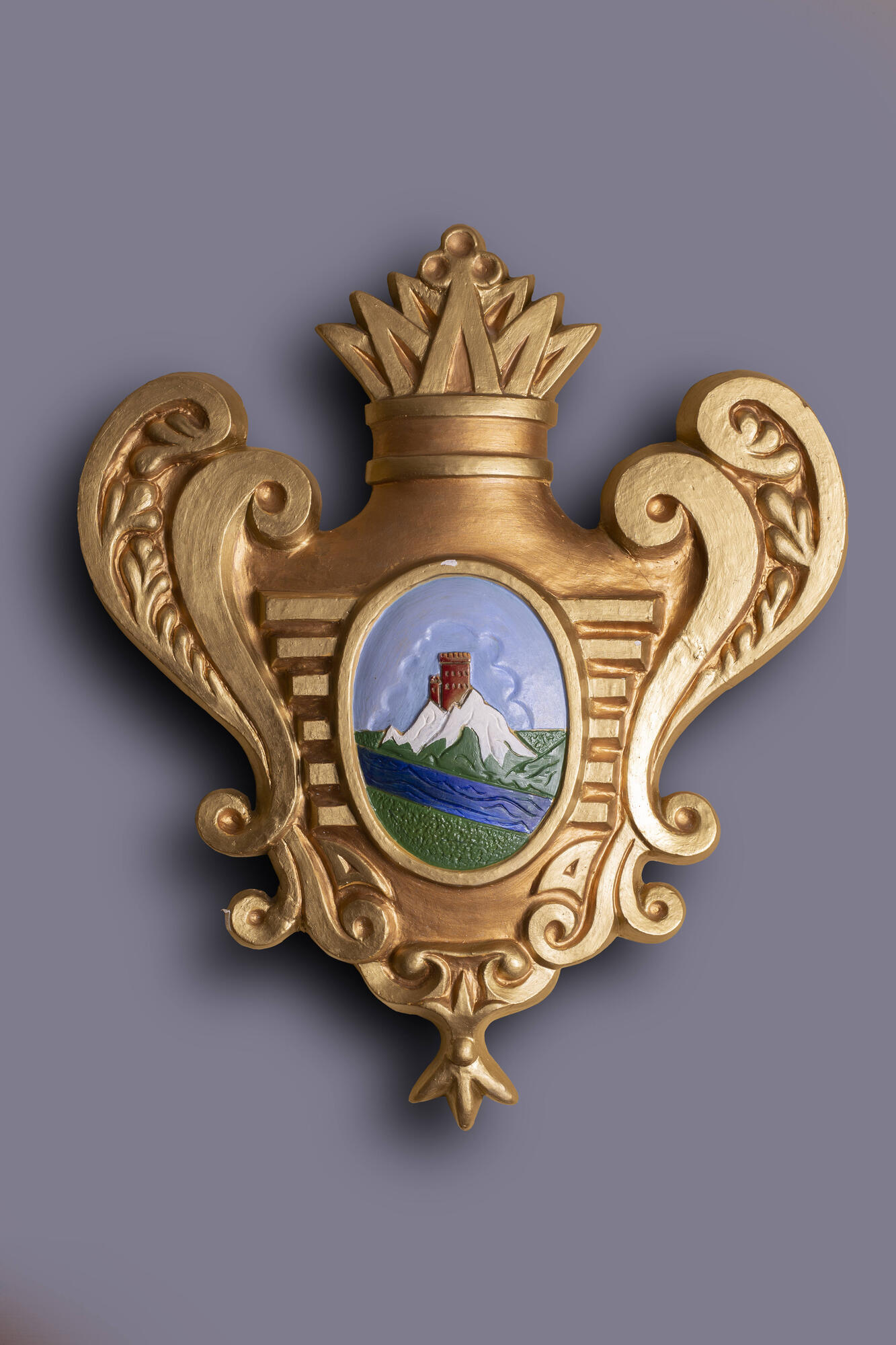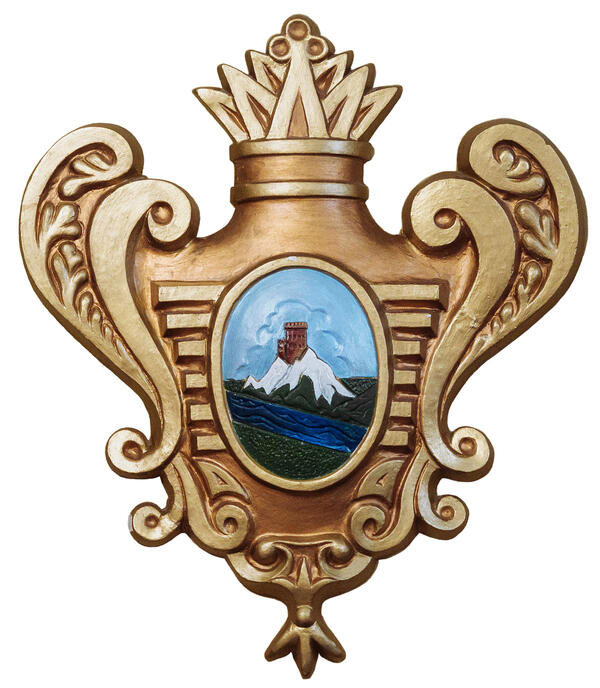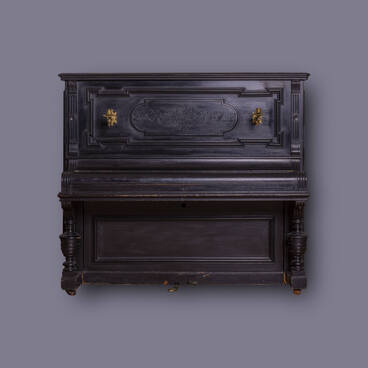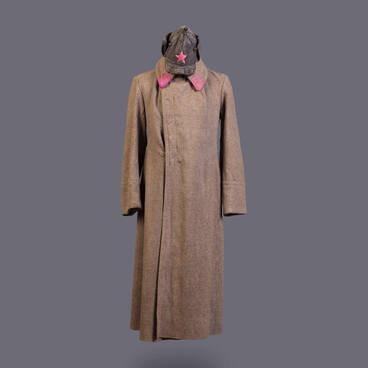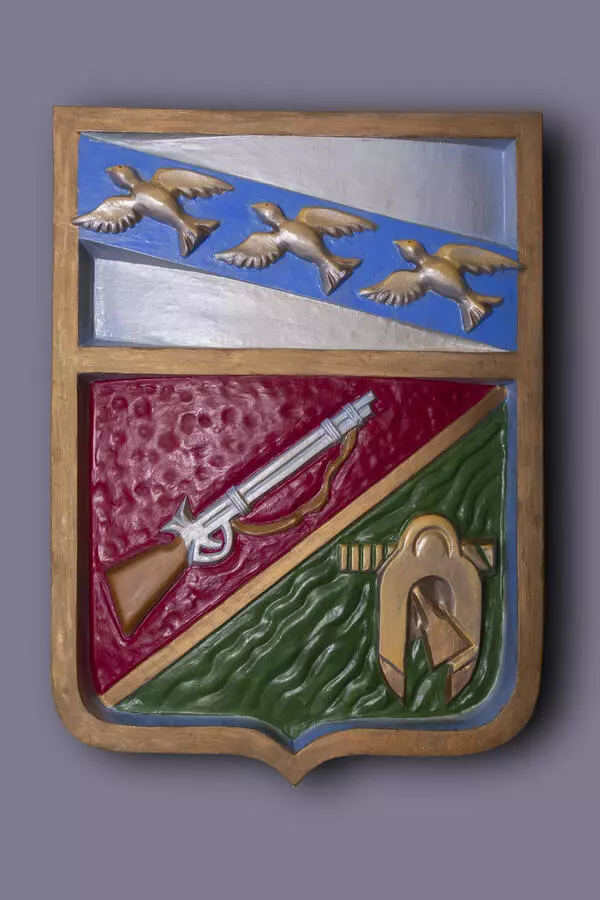The exhibit is a copy of the coat of arms of the Starooskolsky Infantry Regiment, established in 1765. It represents a shield, in the center of which there is a watchtower on a white mountain by the river. There are decorative elements — volutes — around the image, and a stylized crown in the upper part. The coat of arms was made for the permanent exhibition of the hall “Oskol Fortress” in 1996.
The coat of arms of Starooskolsky Infantry or Musketeer Regiment was adopted on January 11, 1765. The regiment was part of the Ukrainian Land Militia Corps. The description of the coat of arms says, “On a golden shield, on a blue field is a piece of green land, crossed by a river, behind which a mountain is visible with a tower of bricks on its top”. The coat of arms was used on the banner and property of the regiment until 1775, when it stayed only for the banner and seal, and in other cases only the national emblem — the two-headed eagle — was used.
The first recruitment to the Starooskolsky Regiment was carried out in 1653. In 1731 the regiment became a part of the Ukrainian land militia. At the end of the 18th century the regiment was part of the Ukrainian Corps, later was attached to the Mogilev Regiment, then again was made a separate unit. In 1863 it was reformed into a three-battalion regiment and was called the 128th Infantry Starooskolsky Regiment.
The Starooskolsky Regiment joined the Danube Army under the command of M. I. Kutuzov in the war with Turkey (1806–1812). It distinguished itself in the Patriotic War of 1812, especially in the military campaign of 1813-1814 — the final defeat of Napoleon’s army. The Starooskolsky Regiment is immortalized on the marble plaques of Christ the Savior Cathedral in Moscow, built to commemorate the victory of the Russian army in the Patriotic War of 1812.
The Starooskolsky Infantry Regiment took part in the Russo-Turkish War of 1828-1829, participated in the defense of Sevastopol in the Crimean War, and distinguished itself in the Russian-Turkish War of 1877-1878.
Among the commanders of the regiment are many famous names in Russia: Semyon Andreevich Poroshin (commanded the regiment from 1768 to 1769) — a writer, scientist, enlightened man of his time, tutor in geometry and arithmetic of the future Emperor Pavel Petrovich; Leontii Vasilievich Dubelt (commanded the regiment from 1822 to 1828) — a participant in the Russian-French War of 1806-1807 and the Patriotic War of 1812, cavalry general; Major-General Alexander Iosifovich Zashchuk (commanded the regiment since 1869) — the hero of the defense of Sevastopol; and many others.
The coat of arms of Starooskolsky Infantry or Musketeer Regiment was adopted on January 11, 1765. The regiment was part of the Ukrainian Land Militia Corps. The description of the coat of arms says, “On a golden shield, on a blue field is a piece of green land, crossed by a river, behind which a mountain is visible with a tower of bricks on its top”. The coat of arms was used on the banner and property of the regiment until 1775, when it stayed only for the banner and seal, and in other cases only the national emblem — the two-headed eagle — was used.
The first recruitment to the Starooskolsky Regiment was carried out in 1653. In 1731 the regiment became a part of the Ukrainian land militia. At the end of the 18th century the regiment was part of the Ukrainian Corps, later was attached to the Mogilev Regiment, then again was made a separate unit. In 1863 it was reformed into a three-battalion regiment and was called the 128th Infantry Starooskolsky Regiment.
The Starooskolsky Regiment joined the Danube Army under the command of M. I. Kutuzov in the war with Turkey (1806–1812). It distinguished itself in the Patriotic War of 1812, especially in the military campaign of 1813-1814 — the final defeat of Napoleon’s army. The Starooskolsky Regiment is immortalized on the marble plaques of Christ the Savior Cathedral in Moscow, built to commemorate the victory of the Russian army in the Patriotic War of 1812.
The Starooskolsky Infantry Regiment took part in the Russo-Turkish War of 1828-1829, participated in the defense of Sevastopol in the Crimean War, and distinguished itself in the Russian-Turkish War of 1877-1878.
Among the commanders of the regiment are many famous names in Russia: Semyon Andreevich Poroshin (commanded the regiment from 1768 to 1769) — a writer, scientist, enlightened man of his time, tutor in geometry and arithmetic of the future Emperor Pavel Petrovich; Leontii Vasilievich Dubelt (commanded the regiment from 1822 to 1828) — a participant in the Russian-French War of 1806-1807 and the Patriotic War of 1812, cavalry general; Major-General Alexander Iosifovich Zashchuk (commanded the regiment since 1869) — the hero of the defense of Sevastopol; and many others.
